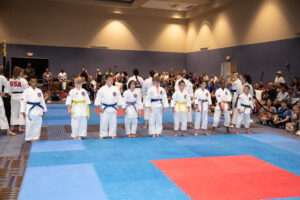
History of the World Martial Arts Games Movement

The World Martial Arts Games Committee was founded in 2005 by both Freddy Kleinschwärzer (GER) and Ken Marchtaler (CAN). The intention is to provide a platform that promotes participation in Martial arts by all, including all Styles, Abilities, Gender, Ages and Backgrounds.
The organization is directed and managed by a committee of international representatives from across the globe from a diverse range of martial art styles and backgrounds (please see the Organization page). The events organized by the WMAGC are intentionally and purposefully inclusive of both male and female participants of all ages and abilities and from all backgrounds.
To uphold and deliver these principles of inclusivity, the WMAGC continually strives to build and develop an international collaborative network, creating cooperative working relationships and practices, where knowledge, experience and opportunities can be shared with Martial Arts organizations across the globe.
The umbrella term of “Martial Arts” is intentional to ensure the diverse range of martial art styles practiced across the globe and at local level are included. The WMAGC aims to be inclusive of the variations in martial arts to ensure that the repertoire of different styles facilitates participation by all, whilst also bringing together the martial arts community to generate international, collaborative relationships.
Participation in the WMAGC events does not exclude anyone based on their gender, background, experiences, ability, opportunities, language, ethnicity, culture or beliefs. Instead it strives to ensure anyone with an interest in Martial Arts gets the opportunity to participate either as a competitor or as part of the event team.
Types of Events
At the World Martial Arts Games, there are divisions for almost everyone—from beginners to seasoned martial artists. Please see below for some of the types of events offered at the World Games and US Martial Arts Team sanctioned events. Please contact us, or a regional coaching center for more information about the rules or for any questions!
Traditional Forms
Traditional forms are judged on based on consistency of technique, focus, and energy. This event honors the deep roots of each style and is judged on the form itself, not how it was taught.
Weapons Forms
Competitors demonstrate their skill and control with wooden and bladed weapons.
Non-Traditional Forms
This event allows competitors to highlight their unique expression and technical flair.
Musical Forms
In this event, the form is performed to music. There are both empty-hand and weapons divisions and these forms blend rhythm, power, and artistry.
Extreme Forms
High-energy performances combining martial arts with flips, spins, and advanced kicks—pushing athleticism to the limit in dramatic, music-backed routines.
Synchronized Team Forms
Teams of two or more perform together in perfect harmony, showcasing precision, timing, and collective rhythm.
Point Sparring (Kumite)
Fast-paced matches where fighters score clean, controlled points. Strategy and timing take center stage in this dynamic, rules-based competition.
Continuous Sparring
Endurance meets precision as competitors engage in a flowing, sustained match. Points are scored throughout the match with a focus on consistent performance and control.
Grappling
Submission-based competition where athletes aim to control and outmaneuver their opponents through holds, escapes, and ground techniques.
Grapple/Strike
A hybrid event that combines takedowns, positional control, and striking. It’s as much about technique as it is about timing and adaptability.
Breaking
Power, focus, and technique collide as athletes break boards, bricks, and more. A test of strength and precision wrapped in dramatic moments.
Self-Defense
Real-world scenarios where athletes demonstrate techniques for escaping grabs, defending against attacks, and neutralizing threats with confidence and control.
